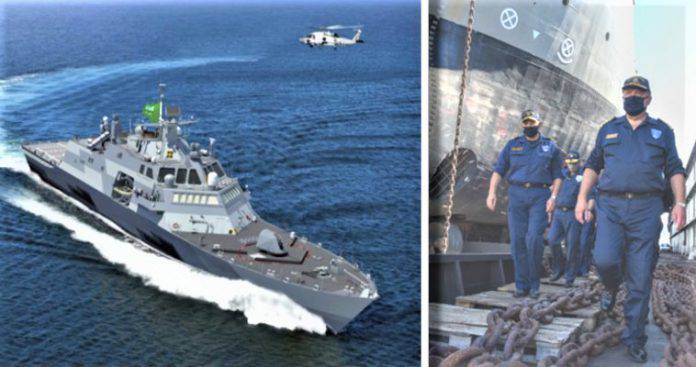Kostas Grivas: Why the made in the USA MMSC frigates are in danger of “sinking”
08/11/2020
In recent days, there have been persistent reports that the Hellenic Navy is interested in buying four American-made MMSC (Multi Mission Surface Combatant) frigates. The author’s view is that the MMSC, like any other ship with similar characteristics and capabilities, with limited range weapons and limited range sensors, not only does not meet the Greek long-term needs but may be a dangerous Achilles heel within the next decade.
The reason is that these ships are not adapted to the potential threat environment of the coming years in the Aegean. This is because they will, necessarily, operate at relatively short distances off the Turkish coast, they will be vulnerable to a series of new threats, predominantly from anti-ship ballistic missiles (ASBM).
About ten years ago, China changed the game on land-to-sea power projection with advanced area anti-access and area denial grids (A2 / AD) designed to remove American Aircraft Carrier Combat Groups (CCG) from the South and East China Seas. Thus, the Chinese made the coastal waters of China very unhealthy for these battle groups, at a range of more than a thousand kilometers. The spearhead of the Chinese effort was the now-famous (ASBM) Dong Feng 21D (DF-21D) ballistic missiles, with a range of about 1700 km.
These missiles operated as part of network-based structures that included means for locating and tracking US ships, which fed the missiles with information during their flight so that they could adjust their course according to the new data. In the final phase, the rocket Belh@arrlaunched a maneuvering re-entry vehicle (MaRV) which undertook to locate and fly towards the target ship using its own sensor.
Because of its very high speed, it was very difficult to stop. In the following years, the Chinese introduced the even higher-performance ASBM DF-26, with a range of 3,000 km, which could threaten smaller ships such as the Arleigh Burke destroyers and the Ticonderoga cruisers.
Post-nuclear weapons
During the big military parade that took place in Beijing in October 2019, the Chinese presented an even more dangerous system, the DF-ZF (or WU-14 as labeled by the Americans), a hypersonic glide vehicle (HGV) on a ballistic missile. The whole system is referred to as DF-17. As hypersonic we refer to a missile or aircraft that can reach a speed at least five times faster than sound (Mach 5). The carrier missile launches the glide vehicle at a high altitude which then moves towards its target “sliding” through the air.
The very high speed and the increased maneuverability make it very difficult to stop even with advanced anti-missile weapons. The Chinese have been described by US experts with the acronym HEAT (High End Asymmetrical Threats) and missiles such as the DF-21D, DF-26 and DF-17 are referred to as “post nuclear super weapons”.
Also, A2 / AD missile networks did not only include anti-ship ballistic missiles or cruise missiles. For a range of less than 500 km, the Chinese used multiple rocket launchers with increased range, the most impressive of which is the Wei Shi 2D (WS-2D) whose range reaches 400 km. Here it is worth noting that the ancestor of WS -2, the WS-1B, formed the basis of the Turkish TRG-300 Kasirga.
In the following years, more and more countries introduced similar A2 / AD systems, creating a death zone hundreds or even thousands of kilometers off their coasts. Russia was, of course, one of them, but Iran also managed to build anti-ship ballistic missiles, the capabilities of which are being taken very seriously by the Americans.
Even state-sponsored high-tech operators, such as the Houthi rebels in Yemen, have been able to build asymmetric A2 / AD capabilities by turning speedboats into vehicle-borne improvised explosive devices (VBIED) and used them to attack Saudi-backed separatists.
Counter-access grids from Turkey
And the big question is whether Turkey has developed or is going to develop similar A2 / AD grids, which will form a new environment to which the Greek naval power will have to adapt. The answer is not known to the writer. However, what we can say with certainty is that Turkey, even if it has not developed similar capabilities, is sure that it can do it today and even more certain that it will be able to do so in the coming years.
First, anti-ship ballistic missiles are already available on the international market. Among others, the Chinese company CASIC offers the CM-401 with a range of about 290 km and also the Chinese ALIT the M20A with a range of 280, which in fact has been reported to have already been acquired by unnamed countries.
Also, Turkey has already shown that it is investing in the development of reconnaissance-strike complexes with unmanned aerial vehicles but also with unmanned surface vessels, such as the recently introduced ULAQ, which provide targeting data for other weapons, or use their own. Incidentally, swarms of unmanned aerial vehicles, loitering munitions, unmanned surface vessels (USVs), or unmanned submarines (UUVs) are also part of the A2 / AD capabilities and unfortunately, Turkey seems to be very ahead of Greece in this area, not because Greece lacks the relevant skills but simply because it does not seem willing to engage them.
In addition, for many years Turkey has invested in the development of a domestic ballistic arsenal, and it has done so largely in cooperation with China. It is therefore natural that it has come into contact with the war methodologies and possibly the relevant technologies developed by China.
For the last 20 years
Finally, the most important thing is that we have a number of indications that Turkey has been studying similar capabilities for many years. For example, many years before the Chinese introduced the DF-21D, in the early 2000s, Israel introduced the LORA ballistic missile, which it said could be used against moving naval vessels. At the time, in fact, we had described the Israelis’ claims about their weapons capabilities as excessive. A few years later, the Chinese proved to us that we were wrong.
The very interesting thing is that Israel made known the existence of the missile when it presented it to the leadership of the Turkish Ministry of Defense, since at that time the relations between the two countries were still excellent. In other words, almost twenty years ago, the Turks were already considering acquiring anti-ship ballistic missiles and apparently did not stop there. In particular, at the DSEi defense equipment exhibition held in Great Britain in 2011, Turkey presented for the first time the SOM cruise missile.
During the presentation of the system, the representatives of the manufacturer stated that the rocket is designed to operate in a network-centric environment, to update the targeting data in flight, and to be able to attack moving surface ships, receiving information from other platforms. So, since then, the Turks have developed reconnaissance-strike grids in order to project power at sea.
Do we need large naval units?
All of the above are very worrying indications that Turkey, if it has not already developed, is extremely likely to develop, in the coming years, strong networks of counter-attack and area denial in the Aegean that will make the operation of large surface units at great distances from the Turkish coasts, precarious. Of course, similar skills can be developed in Greece. And in fact much better.
The geography of the Aegean is as if it were designed to be the basis of an anti-access and area denial complex-of-complexes, which would unify the archipelago structure of the Aegean into a single and indivisible sea-land structure and would make Greek dominance in the area indisputable, as the writer has argued in his earlier articles on SLpress. Of course, this does not mean that we do not need warships.
Large surface units can be the “mobile geography” of power in the high seas of the Aegean and especially in the Eastern Mediterranean, operating outside the range of Turkish A2 / AD weapons. To create a “bridge” of power projection that will unite Greece with Cyprus and in general to control the open sea areas and to be able to strike precision in-depth strikes in Turkey and against aerial targets at long range. But this cannot be offered by large ships with the Harpoon Block II surface-to-surface and surface-to-surface missiles and the ESSM surface-to-air missiles that have a range of only 50 km!
The MMSC frigates, the Belh@arra, and the Arleigh Burke
Ships such as the French frigates Belh@arra, with the Aster 30 surface-to-air missiles with a range of 170 km, and the Scalp Naval cruise missiles with a range of more than 1000 km are required to cover these tasks. Even better, the above tasks can also be carried out by the US Arleigh Burke destroyers using SM-2 surface-to-air missiles and even longer-range SM-6 missiles with capabilities beyond the horizon, which will operate in a network-centric structure using CEC (Cooperative Engagement Capability), or another ship of similar capabilities.
Even if these American frigates are the ticket to get Arleigh Burke destroyers, or even the older Ticonderoga cruisers, as it is rumored, one wonders what exactly they will offer in the long run to the Greek power projection capabilities, based on the new expected technological and operational data mentioned above.
With the above, the author does not claim that American frigates are “bad” and some others would be “good”. All ships with these operational characteristics are in danger of being in dangerous disharmony with the new war reality that is taking shape in near seas around the planet and will certainly have its reflection in our neighborhood and this requires a new philosophy of equipment that will break down the barriers between the individual Branches.





